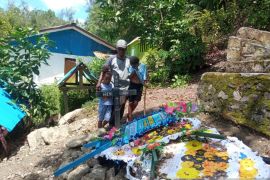May 1, 1963, is the day the United Nations Temporary Executive Authority (UNTEA) transferred control of West Papua to Indonesia, completing a decades-old struggle to free the region from Dutch control.
"On May 1, 1963, our ancestors united to fight for freedom from the colonizers, and the message should be passed on by maintaining Papua in the framework of Indonesia," said TNI's XVII/Cenderawasih Military District Commander, Major General Muhammad Saleh Mustafa, on Monday.
He said Papuan residents must strive to develop their region and added that those who claim that Papua is not a part of Indonesia are making a grave mistake.
"The framework of the Unitary State of the Republic of Indonesia will be a mere symbol and have no value if Papua residents do not contribute by developing their land," he added.
The Statue of Pancasila symbolizes the hope that Papuan residents will join hands with the regional authorities to develop their home region, Mustafa added.
"Hence, the situation in Papua, particularly in Keerom district, will be better, and it will start from this Pancasila Statue," he stressed.
Although made using only brick and mortar, the simple Statue of Pancasila still emanates the message that unity, integrity, and solidarity must be the foundation for realizing a better future, he added.
"No matter their background, every individual who see the Statue of Pancasila will be a part of Keerom district and is obligated to develop (the region) and realize prosperity for residents in the region," Mustafa emphasized.
The major general also expressed hope that local religious, customary, and youth figures would contribute to developing their community and that residents of Waris sub-district will be pioneers in realizing prosperity for all Papuan residents.
Related news: Papua Police confirms wanted separatist killed by rival
Related news: Govt continuing to push development in Papua despite threats: KSP
Translator: Ardiles Leloltery, Nabil Ihsan
Editor: Anton Santoso
Copyright © ANTARA 2023












